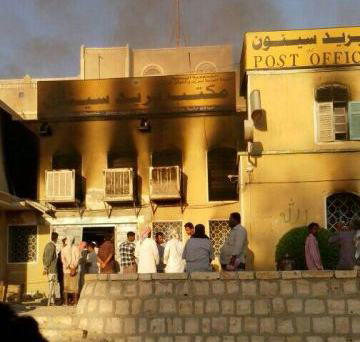
When I first arrived in Yemen, early in 1978, I found a virtual janna, a country building itself up by the sandalstraps, people who were welcoming, tribesmen who did more than wear their honor on their sleeves, a sense that the future would bring good things. It was not a land frozen in time, despite the lack of infrastructure and Western amenities, but a force for change as Yemenis took to entrepreneurship as second nature (which it, of course, always was). Development was in the air and on the ground, as bilateral and United Nations agencies poured money into Yemen, much of it ineffectual and wasted. In 1978 USAID was sponsoring a major sorghum improvement project in Yemen, a boondoggle that did little more than collect seeds for the University of Arizona’s seed bank. Given what I learned about Yemeni farmers’ knowledge, they should have been giving advice to the United States on how to grow sorghum. Much ado was made about building up the capacity of the central government, although the money flowing in through the various programs invited corruption rather than sustainable growth. Still, I have felt over the years that Yemenis, by and large, have the resolve and grit to persevere.
In the past three and a half decades Yemen has experienced ups and downs. A population estimated around 6 million or less back then has skyrocketed to some 24 million today. With the decline in subsistence agriculture, which at least filled stomachs, poverty and malnutrition are greater today than they were in 1978. The devastating loss of remittance wealth, which fueled Yemen’s grass-roots development in the 1980s, has led to chronic unemployment. The much touted unification in 1990, a kalashnikov wedding in hindsight, could not overcome the power politics and regional rivalry that have played out in the last two decades. The removal, or at least side-lining, of Ali Abdullah Salih has thus far not resulted in progress towards a peaceful solution to Yemen’s agonizing conflicts. The problem is not so much the inability of Yemen to renew itself, but the continual interference from outside forces. The money pouring in from neighboring states, especially the one directly to the north, has fueled rather than cooled the fires. The policy of the United States in using Arabia Felix as a drone field has exacerbated the “terrorism” it so blatantly and ineffectively targets.
Many pundits think of Yemen as a failed state, but it is better to think of Yemen as having been failed by the states and power brokers which have interfered in Yemen’s internal politics. This is especially true of the Huthi rebellion. It certainly did not start out to restore the old Zaydi imamate, but in direct response to the Saudi-backed Salafi brand that created a sectarian antagonism not found in Yemen before. Ali Abdullah Salih could not have devastated the south he was so keen to unify without major outside support for his regime. The military aid that was theoretically sent to rid Yemen of terrorists was used to terrify both southerners and Huthi supporters. There is indeed violence in Yemen today, but it is not as home grown as many pundits think.
The news today is of a cowardly attack by al-Qa’ida militants on security, military and government facilities in Seiyun, the second largest town in the Hadramawt. This is wanton destruction in which at least 16 people were killed, ten of them soldiers. Killing soldiers is particularly egregious because these are mainly young Yemeni men with few other options for employment. Such madness amounts to men metaphorically killing their own sons. Yemen’s south has suffered far too long, especially with the inability of the government to effectively root out the extremist Ansar al-Shari’a and its AQAP allies, which subject the local population to outdated “shari’a” rules that have been abandoned throughout the Muslim World. If Ansar al-Shari’a would take time out for shouting their slogans to actually reading the Sira of the Prophet, they would find that Muhammad was a force for peace, not a terrorist. When he finally returned to Mecca, after all the abuse directed at him and his followers, he entered as a peacemaker.
The Qur’an mentions the janna that was in Yemen due to the agriculture supported by the Ma’rib dam. This is what needs to be restored in Yemen, not yet another killing field like Syria or Sri Lanka or Cambodia or Rwanda. Let those who would create jahannam on earth taste it in the afterlife.